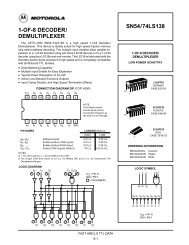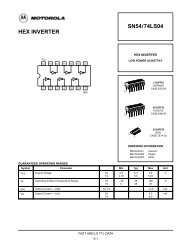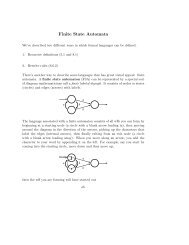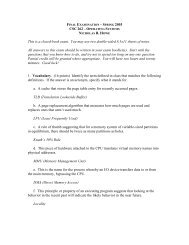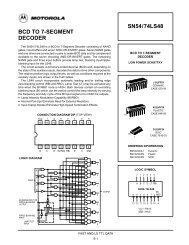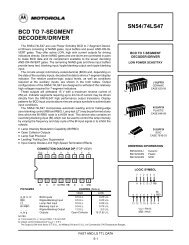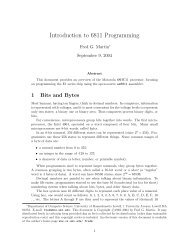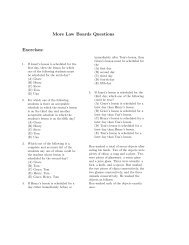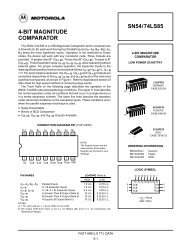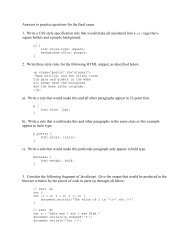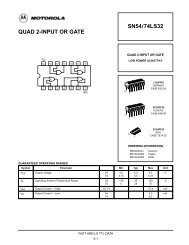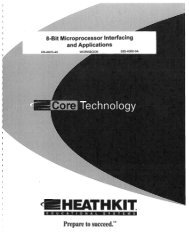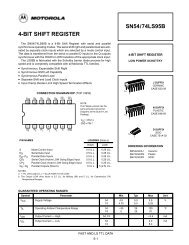Modified Moore method - Smith College
Modified Moore method - Smith College
Modified Moore method - Smith College
You also want an ePaper? Increase the reach of your titles
YUMPU automatically turns print PDFs into web optimized ePapers that Google loves.
19821 THE TEACHING OF MATHEMATICS 489<br />
The <strong>method</strong> effectively raises the level of communication between students. Since all students<br />
are responsible for all questions on examinations, the presenting teams try hard to teach and the<br />
other students demand the clarity they need in order to learn.<br />
Since students write every week and receive prompt evaluation of their writing, they make<br />
substantial improvement. They also learn to appreciate the connection between understanding a<br />
subject and writing about it.<br />
Furthermore. most students respond wel! to the responsibility placed on them by the <strong>Modified</strong><br />
<strong>Moore</strong> <strong>method</strong>. They are willing to work hard for a teacher who pays attention to their thinking<br />
and writing. I find that the percentage of students who drop courses taught by the <strong>Modified</strong><br />
i <strong>Moore</strong> <strong>method</strong> because they are burdensome is no higher than the percentage who drop other<br />
courses for that reason. Most students are stimulated by the change from passive to active<br />
1, learning.<br />
Appendix. Below is a sample syllabus and the basics and questions for class meeting number<br />
six for the course Introductory Real Analysis taught for four years at <strong>Smith</strong> <strong>College</strong> by the<br />
<strong>Modified</strong> <strong>Moore</strong> <strong>method</strong>. The course is for sophomore and junior mathematics majors. The<br />
prerequisites are Multidimensional Calculus and Linear Algebra. There are ten weeks available for<br />
class meetings out of the 13-week semester and the total number of questions for the course is 27.<br />
Week<br />
1. Orientation<br />
2. Class meeting 1: Metrics; completeness of the reals; open and closed subsets of the reals.<br />
3. Class meeting 2: Limit points; Bolzano-Weierstrass Theorem.<br />
4. - 3: Continuity of functions, introduction.<br />
5. - 4: Continuity of functions, sums, products, compositions, examples.<br />
6. - 5: Differentiability of functions.<br />
7. - 6: Cauchy sequences of reds; pointwise and uniform convergence of sequences<br />
of functions.<br />
8. Examination<br />
9. Class meeting 7: Theorems on uniformly convergent sequences of functions; Weierstrass<br />
M-Test.<br />
10. - 8: Analytic functions; Taylor's Theorem.<br />
11. - 9: Lebesgue measure, introduction.<br />
12. - 10: Lebesgue integral, introduction.<br />
1 3. Examination<br />
i<br />
I<br />
L<br />
Basics for Class Meeting Six. (Week 7)<br />
DEFINITIONS: a Cauchy sequence of real numbers, the limit of a sequence of real numbers, the<br />
pointwise limit of a sequence of functions, the uniform limit of a sequence of functions.<br />
Questions for Class Meeting Six. (Week 7)<br />
1. Show that the sequence of functionsf,(x) = xn converges pointwise but not uniformly on<br />
[O. I] to the function<br />
2. Show that the sequence of functions f,(x) = I - xn converges uniformly on [-p, p] for<br />
anyp with lplc 1.<br />
References<br />
1. J. Gersting and J. Kuczkowski. Why and how to use small groups in the mathematics classroom. Two-year<br />
Coll. Math. J.. 8 (1977) 270-74.




